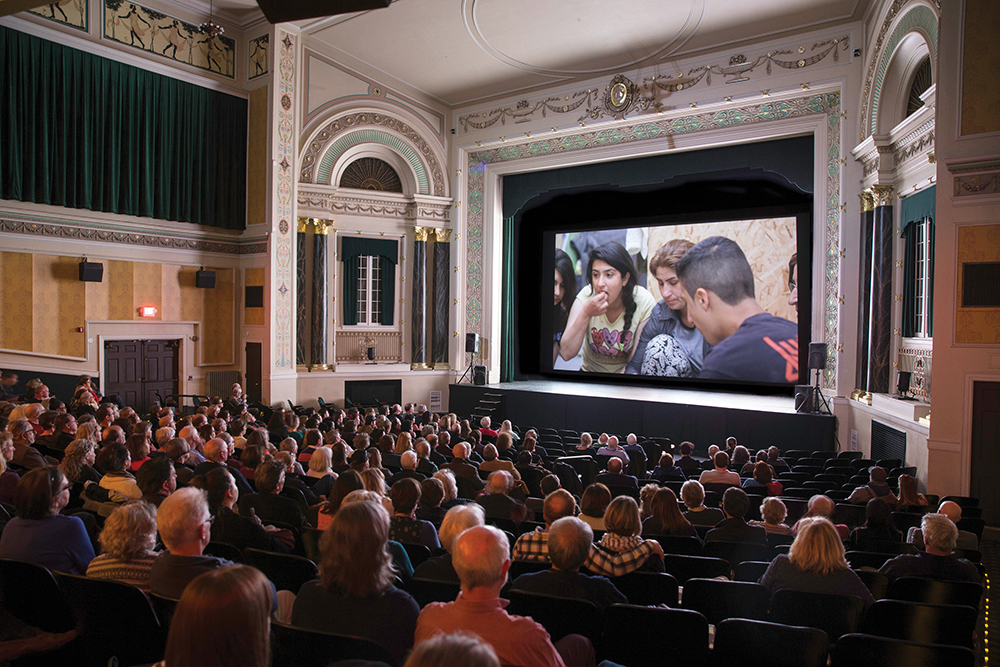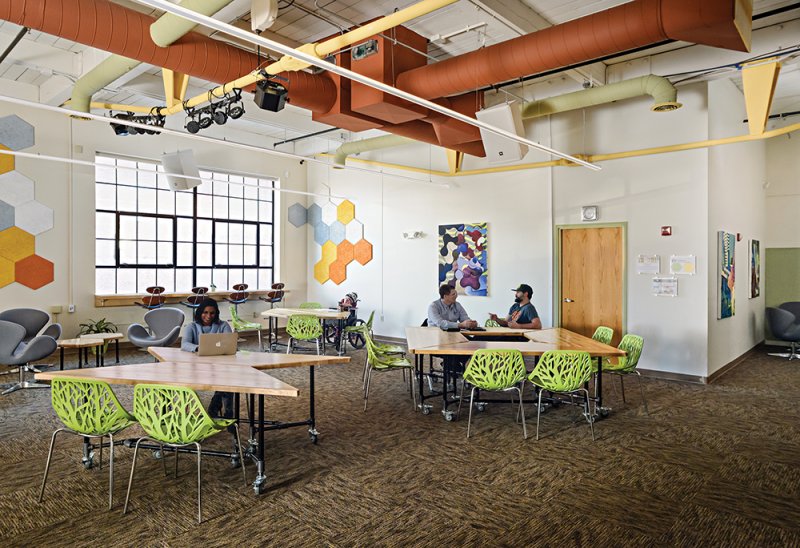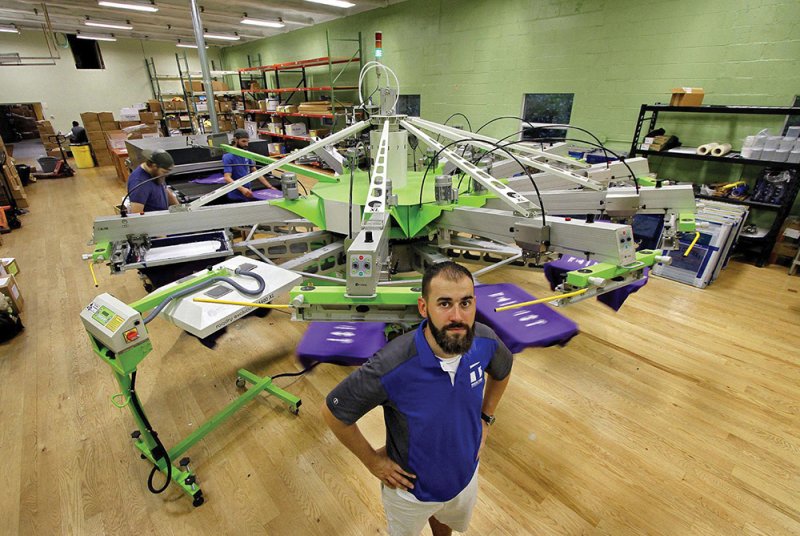
Courtesy of the City of Keene.
About five years ago, Danya Landis was living the dream as a professional artist in New York City. She had a job, friends and professional connections in one of the world’s cultural hubs. Little did she suspect that a visit to the Monadnock Region—specifically Peterborough and Keene—would change her life and lure her away from the big city. Within her first hour, she met her future husband; in the second hour she met her future business partner; and then she spent the evening with people who are now close friends and associates.
Landis not only felt the pull of this bucolic place, she saw a need that she could help fill. As an artist from New York, she was used to being within a few steps of a gallery or an art space. And while she found no shortage of artists and creatives in Keene, there was a dearth of venues for them to show or produce their work.
She eventually moved to NH and, with business partner Rebecca Hamilton, began building a company that could rectify that.
They launched Machina Arts at the Hannah Grimes Center for Entrepreneurship in Keene. While technically an events management company with a goal of opening a gallery and restaurant, Machina has also organized pop-up art installation parties, instituted monthly live music mixers, and resurrected First Friday art walks, becoming instrumental in raising the profile of the arts and artists in Keene.
“The creative economy is growing like crazy here,” says Nancy DuBosque, regional director of the Keene office for the NH Small Business Development Center, adding that more can be done to support and expand this sector. “Affordable and smaller-scale space is critical to support the creative economy,” she says.
That growing creative economy includes MoCo Arts, a nonprofit arts education organization, which recently opened a state-of-the-art performing arts center and school in downtown Keene.
According to a 2016 survey by Arts Alive, a local nonprofit that promotes and supports the arts in the region, the collective economic impact of arts organizations in the Monadnock Region totals $18.6 million, with local and state governments taking in roughly $1.9 million in revenue from the arts. Further, their survey found that arts and culture organizations, and spending by their audiences, support 659 jobs in the Monadnock Region and that 89 percent of nonlocal audiences say that the arts brought them to the region.
Keene even plays host to the Monadnock International Film Festival (MONIFF) that has become a big audience draw and a signature event every April. The film festival is changing the days it runs from Thursday through Saturday to Friday through Sunday in 2019 in an effort to boost attendance. “We want this festival to become a destination weekend for out-of-town visitors to come here and spend a night or two. It’s easier for them to take off on a Friday afternoon than a Thursday afternoon; plus they can watch films all day Saturday and Sunday,” says Dianna Costello, MONIFF’s executive director.

The Monadnock International Film Festival held at the Colonial Theatre. Photo by Gunnar Rathbun.
Elizabeth A. Dragon, Keene’s city manager, notes that these kinds of projects have significant buy-in from the community.
“Another positive sign of a good economy is that the local community is investing in [and] raising significant funds for projects such as the library expansion and MoCo’s new building,” Dragon says. “These projects would not be possible without the generous donations of the community and add greatly to the way of life in Keene.”
This activity around the arts even inspired Keene officials to enact the city’s first policy on adopting and accepting public art either temporarily or permanently, Dragon says. “We just accepted our first project utilizing this policy at the airport,” she says. “[And] the nationally recognized Wall Dogs are coming to Keene to paint murals in 15 locations throughout downtown.
Arts and culture are an important part of the discussion at the mayor’s economic development committee meetings.”
Phil Suter, president and CEO of the Greater Keene Chamber of Commerce, says the Wall Dogs installation in particular will literally change the face of Keene for years to come. “There is no question that arts and culture are a key part of our brand,” says Suter. “The arts community is very active in producing events and in advancing public policy initiatives that are welcoming to artists.”
Attracting Young Entrepreneurs
There also seems to be a shift in Keene’s demographics and economy. While the average age of startup business owners at the Hannah Grimes Center, a business incubator and educational center, still hovers around 50, younger creative entrepreneurs are making their mark. “We have some more visible small businesses that are just starting, like Machina Arts, that are run by young entrepreneurs,” says Mary Ann Kristiansen, executive director of the Hannah Grimes Center.

The Hive at the Hannah Grimes Center for Entrepreneurship. Courtesy photo.
Other small to midsize businesses such as Beeze Tees Screen Printing and The Bread Shed bakery are also run by entrepreneurs younger than 40. Landis points to the business culture and climate of Keene as one of the reasons for that, as well as the resources available to startups and young entrepreneurs.

Keene is home to a number of businesses run by young entrepreneurs, including Tim Pipp of Beeze Tees Screen Printing, above (Michael Moore/The Keene Sentinel) and Brittany Migneault, owner of The Bread Shed in Keene, below (courtesy photo).
 “It seems a lot of young people around here are starting small businesses, and I think for one thing that’s because Hannah Grimes is here,” Landis says. “It’s incredibly important to have that mentorship. It helps young business owners feel more comfortable.”
“It seems a lot of young people around here are starting small businesses, and I think for one thing that’s because Hannah Grimes is here,” Landis says. “It’s incredibly important to have that mentorship. It helps young business owners feel more comfortable.”
The fact that there are other visible young entrepreneurs to connect and network with is valuable. “Within my social circle, the majority of us are working toward working full time, or close to it, for ourselves,” Landis says. “There are so many passionate people who are so supportive. And I can go to them and say, ‘Hey, how do you do this?’ And they’ll do the same in return. That’s really common here.”
Healthy Business Mix
Small businesses are at the heart of Keene’s economy. Medard Kopczynski, director of economic development, initiatives and special projects for the City of Keene, says the City focuses on what it can do to retain those small businesses as well as attract new ones. After all, he says, it’s a lot easier to retain and grow a business than to recruit one.
Kopczynski says that while Monadnock Economic Development Corporation (MEDC) has done a good job of recruiting new businesses to the region, Keene does not have a formal recruitment effort. (MEDC Executive Director Jack Dugan did not reply to requests for comment from Business NH Magazine about those efforts.)
That said, Dragon points to some larger-scale projects, such as the completion of Hillside Village Retirement Community, as initiatives that helped Keene see a significant jump in assessed value equal to $21,840,443. The city was also able to attract Unity Homes, an offshoot of Bensonwood Homes in Walpole, which recently opened a factory in Keene.

The Keene factory for Unity Homes and Bensonwood Homes. Courtesy photo.
Further, says Suter, Keene has a long history of manufacturing. There are high tech and advanced manufacturers, including Stingray Optics, Filtrine and Smith’s Medical.

A Stingray Optics lens in use. Courtesy photo.
Keene has its share of large employers as well, including C&S Wholesale Grocers, the largest wholesale grocery supply company in the U.S.; Cheshire Medical Center, which is part of Dartmouth-Hitchcock; Markem-Imaje, a global provider of marking and printing technology; and The Melanson Company, a roofing contractor that ranks among the top 100 private companies in NH for revenue.
Suter says the city also offers a vibrant downtown with, “mostly locally-owned restaurants and shops,” which along with the iconic Colonial Theatre is an important economic engine.
College Town
Another major employer and economic driver is Keene State College, despite its recent financial woes.
In 2017, the University System of NH, which oversees Keene State College and several other public colleges and universities in the state, directed the school to make cuts in order to rectify a $2.4 million budget deficit. That deficit actually turned out to be about $13 million, says Susan LaPanne, Keene State’s vice president of finance, who was hired in March 2018.
 The deficits were due in large part to a decline in enrollment over the past several years while the school remained staffed at higher levels. “We had too many employees,” LaPanne says. Through a series of “voluntary separations” and across-the-board budget cuts, LaPanne says the school, under the leadership of Melinda Treadwell, its new president (pictured), has been able to right the ship. Treadwell began serving as interim president in July 2017 and was named president in October 2018.
The deficits were due in large part to a decline in enrollment over the past several years while the school remained staffed at higher levels. “We had too many employees,” LaPanne says. Through a series of “voluntary separations” and across-the-board budget cuts, LaPanne says the school, under the leadership of Melinda Treadwell, its new president (pictured), has been able to right the ship. Treadwell began serving as interim president in July 2017 and was named president in October 2018.
“We told everyone, you’re all going to have to give until it hurts, and they have all given until it hurts,” LaPanne says. “As of the end of June, we hit our budget target that Melinda had negotiated with our board of trustees, and that allowed us a deficit of $2.4 million. … This year, we are on target to come in at a balanced budget. So we will have a zero bottom line.”
She says the institution is still in the process of “right sizing” and finding creative ways to fund projects. She anticipates the belt tightening will continue for at least the next one to two years.
While this was a tumultuous time for the college from the city’s perspective, it has actually led to a stronger relationship between town and gown over the past two years. “It has driven them to reexamine a lot of their operations, I think for the better, by the way, because what they are doing is becoming more conversant with and cooperative with the city itself” Kopczynski says. “I think there’s been a lot of coplanning that didn’t take place in the past. We’re beginning to look at Keene State now as part of our lower downtown, our lower Main Street, as opposed to being a separate entity.”
He adds that Keene State has taken a close look at how to work better with adjacent neighborhoods to improve relationships, and it has strengthened its connections with local industry to better meet workforce needs.
Keene State recently announced a new partnership between the chemistry department and Polyonics, a company in Westmoreland that develops and manufactures industrial labels, to provide students with internship opportunities. Over the past year, the college actually added faculty to its nursing program and added more medical and surgical classes and clinical time. The improvements resulted in the program receiving a 10-year accreditation from the American Association of Colleges of Nursing.
Last year, Keene State gave out 926 undergraduate degrees to 908 graduates and welcomed a freshman class of 950 students.
Development Efforts
The city is doing some reexamining, some businesses would argue, for the better. Dragon says Keene has taken several important steps over the past year to encourage economic development and redevelopment. These efforts include adding an economic development position, creating the Choose Keene website, producing a package of marketing materials for businesses interested in moving to Keene, and even reorganizing City Hall’s fourth floor—which includes zoning, planning, health and permitting—into one combined Community Development Department.
Dragon says the city has also started its “Building Better Together” project, which is a program meant to help businesses navigate the development process. “The updated structure will provide a set of clear procedures for development queries and will create a more streamlined application process, eliminating the need to navigate multiple points of contact,” Dragon says.
She says this project should be completed in 2019 as the city also continues working with the mayor’s Economic Development Committee to update the economic development plan and focus on challenges like workforce expansion.
Further, Kopczynski says, the city has adopted RSA 79-E, the Community Revitalization Tax Incentive that allows a commercial property to receive a period of relief from increased property taxes in exchange for improving the building.
“I think the city is doing an awful lot to improve itself and correspondingly work with the community in determining its future,” Kopczynski says.

 Current Issue - July 2024
Current Issue - July 2024